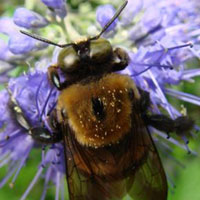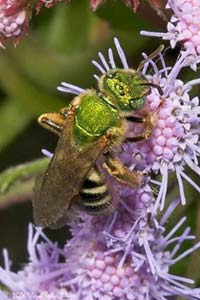The Greenbelt Native Plant Center (GNPC), a facility of the New York City Department of Parks & Recreation, is a 13–acre greenhouse, nursery, and seed bank complex located on Staten Island, NY.
Pollination Biology : Bee Watchers
WANTED: Official Bee Watchers
As a key part of this program, working in each of NYC's boroughs, the Greenbelt Native Plant Center and the Center for Biodiversity and Conservation at the American Museum of Natural History recruit citizen scientists to collect data on pollinator bee species in their own neighborhoods and backyards.

The Greenbelt Native Plant Center (GNPC) and partner American Museum of Natural History/Center for Biodiversity and Conservation (CBC) created this program to study native bees in New York City and the indigenous plants they pollinate.
The recent mysterious loss of European Honeybee populations in the United States, referred to as Colony Collapse Disorder (CCD) has made headline news. Coverage of this phenomenon has dramatically increased public awareness of the importance of all bee pollinators and has provided an opportunity to increase understanding of native pollinators.
Bees, especially native bees, are essential partners of many flowering plants. Approximately 800 species can be found East of the Mississippi River, and a surprising number—over 200—have so far been documented within NYC. But our native bees are disappearing along with the honeybees. In recent years, we have lost seven species, including two bumblebee species, from the region. Other native species are likely in decline, but we lack sufficient information to assess their status.
Discovering which bee species can be found in the city, and which species no longer exist here, will help us to determine which native plants, no longer able to count on their pollinator(s), need closer management and should be targets for propagation at the GNPN for future restoration projects. It will also help us identify the bee pollinators in need of increased protection and management.
Project
Bee Watchers
Partners
- American Museum of Natural History/Center for Biodiversity and Conservation (CBC)
- Volunteer Bee Watchers
- Greenbelt Native Plant Center (GNPC)
Duration
The project began in 2007 and will continue indefinitely.
Rationale
Pollination is vital to our survival and the existence of nearly all ecosystems on earth. 80% of the world's crop plants depend on pollination. Pollinators, almost all of which are insects, are indispensable partners for the source of most of our food, fibers, medicines, fats, and oils. Insect pollinators pollinate products amounting to $20 billion annually in the US alone.
Without pollinators, humans and ecosystems cannot survive. Due to biodiversity threats such as land development, pollution, and pesticide poisoning, we are fast losing pollinators around the world.
This project will lead to greater knowledge of these pollinator species in our urban ecosystem, will increase involvement of citizens from a variety of backgrounds leading to increased awareness, and will provide new data that will lead to more sophisticated management and restoration efforts in our city.
Goals

Engender an increased sense of citizen stewardship of the City's natural resources.
Add significantly to our knowledge base of the most important native pollinators, which will inform management efforts by NYC Department of Parks & Recreation to improve pollinator and host sustainability.
Objectives
Engage the city's citizens to learn about our own rich biodiversity, which includes our native bees, their value, and how to better manage habitats for them.
Activities
- Work with other urban bee projects also addressing this pressing issue, such as San Francisco–based national bee monitoring program.
-
Outreach and training
- All participants are instructed in the parameters of the study.
- Volunteers are trained in the rudiments of bee identification necessary for the pollination survey.
- Participants are shown how to record observations in a standard data format.
-
Materials
- Six native flowering plants from GNPC, all of which are bee pollinated, are distributed, with instructions for planting at their own homes, along with a cultivated sunflower variety, which links our study to the efforts in San Francisco.
-
Data collection
- Volunteers observe bee visits to flowering plants at selected times throughout summer and fall.
- Participants record the category of bee, the date, and time of each bee visit to the specified plant.
- Observers submit data, which is compiled and analyzed by the project staff
- Information from this ongoing bee survey, such as which pollinator species occur where, which species are lacking from critical areas, and which areas are deficient in host plant populations, will lead directly to management strategies, such as propagation and planting of relevant pollinator plant host species by the GNPC and NRG to improve pollinator and host population health.
Presentations
Watch a powerpoint presentation on Plants and Pollination Biology by Dr. Jim Lewis, plant ecologist at Fordham University
Related Links
For more information, please visit the North American Pollinator Protection Campaign (NAPPC) website.